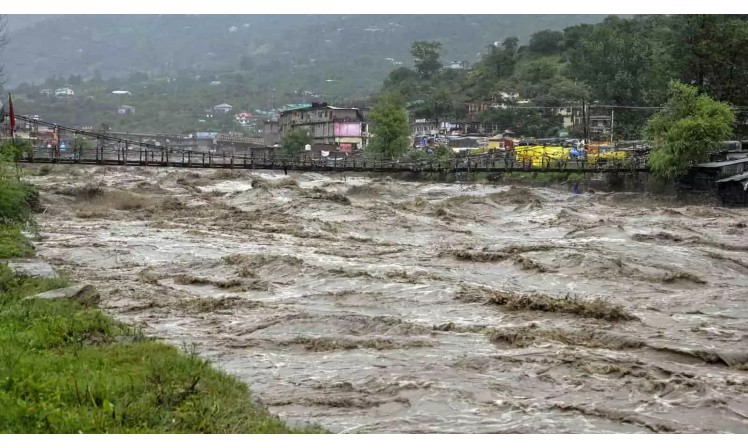
Image Source: Agencies
Sept 2, 2025: In several areas of the flood-ravaged Punjab, fresh rains in Himachal Pradesh and Jammu and Kashmir have halted activity. On Tuesday, torrential rains fell on a number of flood-affected parts of Punjab, further disrupting daily life and making the already dire flood situation even more dire. Rivers including the Sutlej, Beas, and Ravi, along with several seasonal streams, are in spate due to intense rainfall in their upstream catchment areas in Himachal Pradesh and Jammu & Kashmir.
Districts such as Pathankot, Gurdaspur, Fazilka, Kapurthala, Tarn Taran, Ferozepur, Hoshiarpur, and Amritsar are among the worst-hit, with numerous villages inundated.
In Ludhiana, the district administration temporarily shut down all dyeing units in industrial areas along Bahadur Ke Road, Tajpur Road, Moti Nagar, and other zones due to backflow from the Sutlej River affecting operations at the Bhattian Sewage Treatment Plant. The overflow has led to surcharged sewer lines, posing a risk of waterlogging in low-lying areas.
Sultanpur Lodhi in Kapurthala was severely impacted by continuous overnight and daytime rain, which exacerbated the flood situation. The rising Beas River is now damaging standing paddy crops across over 50,000 acres and threatening nearby embankments, known locally as dhussi bandhs.
Additionally, Phagwara experienced heavy rainfall, which resulted in waterlogging in low-lying areas. Rainwater entered several shops along Gaushala Road, causing significant damage to goods and property.
In Ferozepur, floodwaters from the swollen Sutlej have affected over 28,000 residents across 112 villages. Relief and rescue operations are ongoing, with teams from the National Disaster Response Force (NDRF), Indian Army, Border Security Force (BSF), Punjab Police, and local authorities working round the clock.
Citizens have been asked to remain alert, avoid unnecessary travel, ensure rooftops are clear of water stagnation, and report structurally unsafe buildings to authorities so that precautionary measures can be taken.
2,000 vehicles stranded in Mandi, Kullu as landslides wreak havoc:
Torrential rains continue to batter Himachal Pradesh's Mandi district, unleashing a spate of landslides that have paralysed road connectivity, disrupted essential services, and displaced several families from their homes. The situation remains grim as more than 257 roads have been rendered impassable, cutting off key areas and causing widespread logistical challenges. The Kiratpur-Manali four-lane highway, a critical arterial route connecting Kullu-Manali, Lahaul-Spiti, and Leh-Ladakh, remains blocked for the second consecutive day due to multiple landslide incidents between Mandi and Banala. As a result, more than 2,000 vehicles are stuck in Mandi and Kullu, posing a problem for commuters and tourists as the weather gets worse. The alternative route via Kataula has also been closed following another landslide, leaving no immediate detour for traffic movement between Mandi and Kullu. This dual blockade has severely impacted transportation services across the region.
Ghaggar river's rising waters threaten villages near Patiala:
While the rain has stopped in Patiala, the fear of floods continues to loom around the villages near the banks of the Ghaggar river. The Ghaggar's water level has reached the danger level, particularly in the vicinity of Sarala Kalan village. At the moment, the water is flowing at 16 feet, carrying 27,195.94 cusecs of water. The water level in this particular area was flowing at 13 feet when it was last monitored at 10 p.m. on Monday night. In a respite for people living around Zirakpur and Derra Bassi, the gauge level data collected on Tuesday morning states that the water level in the river near Bhankarpur village on the Chandigarh-Ambala Road Crossing Bridge is at 4 feet, much less than the 10-foot gauge. However, the Tangri River, which covers much of the areas in Haryana and crosses through parts of Patiala, is flowing 1.7 feet over the danger mark of 13.7 feet, carrying 40,825 cusecs of water, followed by the Markanda River, which is flowing with a gauge reading of 21.2 feet, while the danger mark stands at 22 feet. However, in a respite for Patiala residents, the water level in Patiala stands at 3.5 feet, much less than the peak gauge level of 12 feet. Inputs from Mohit Khanna/Patiala.
Yamuna crosses danger mark in Delhi, water level likely to rise further:
The water level of the Yamuna river rose to 205.80 metres at Delhi's Old Railway Bridge Tuesday morning, crossing the danger mark of 205.33 metres, an official said. The rise poses a threat of flood in low lying areas of the city. On Monday, Delhi Chief Minister Rekha Gupta said that the government is fully prepared to handle the situation.
According to officials, the river was flowing at Old Yamuna Bridge at 205.68 metres well above the danger mark 205.33 metres at 6 am. It received a discharge of 1.76 lakh cusecs from Hathni Kund Barrage, 69,210 cusec from Wazirabad Barrage, and 73,619 from Okhla Barrage, they said. The level rose further to 205.80 metres at 8 am with the inordinate discharges from the three barrages. With the record release of water from Haryana, in Delhi, authorities are on high alert. People living in the Yamuna floodplains have been advised to relocate. By the evening, it is anticipated that the Yamuna's water level will reach the evacuation threshold of 206 meters.
Leave a comment: (Your email will not be published)